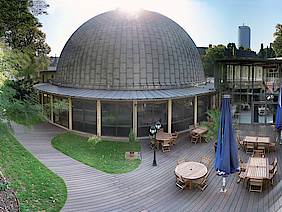With the help of a special projector an artificial night sky with the planets and fixed stars is projected onto a white inner dome. The Zeiss-Planetarium in Jena, Germany, is the oldest continuously operating planetarium in the world. Thanks to new projection technology and 3D-Sound-System, it is also one of the world’s most modern planetariums. It was opened on 18 July 1926. The diameter of the dome is 23 meters and the total projection area covers 900 square meters.
How Jena has shaped the history of planetariums
An early idea of creating an artificial night sky was presented in the 17th century in northern Germany. Up to 12 people fit inside a giant, three-meter globe where they could marvel at the gold-plated nails on the ceiling glimmering in candlelight, which recreated the constellations in the night sky.
Erhard Weigel, a scholar in Jena, was probably inspired by this new technology and built a similar system on the roof of his castle in Jena in 1661. The stars were created by holes in the outer wall of a five-meter dome.
In 1913 Oskar von Miller, founder of the <link http: www.deutsches-museum.de _blank>Deutsches Museum in Munich, contacted Dr. Walther Bauersfeld at Carl Zeiss in Jena about the construction of a “rotatable star dome.” However, it didn’t seem possible to build a large, heavy dome to move with the stars. Instead, Bauersfeld wanted the stars to move independently and designed a device on the basis of optical-mechanical light projection. The first projector from ZEISS incorporated 31 projectors to beam 4500 stars on the inside of a dome. One of the first shows was held in Munich in 1923.
Carl Zeiss in Jena continued to enhance the projector and installed a test projector on the roof of the factory – also making it available for public shows. Almost 80,000 people visited the “Wonder of Jena” from August 1924 to January 1926. This high demand led to the construction of the current ZEISS planetarium.
Reopening of the first projection planetarium in the world
The official Germany start of the International Year of Light happened on February 27, 2015 in Munich. The German Physics Society (DPG) deliberately chose that date to coincide with the reopening of the Munich Zeiss Planetarium. Since 1925 about 8.5 million visitors enjoyed the artificial night sky and learned about astronomy in the Munich planetarium dome. The German Museum is now housing its fourth planetarium generation made by ZEISS. The first presentation after an extensive reconstruction of the planetarium showcast the Fulldome Teaser that ZEISS produced especially for the International Year of Light.
The short film approaches the phenomenon of light in a way that is both fascinating and informative and takes planetarium visitors on a trip through the varied facets of light.
Special events at the ZEISS-Planetarium Jena
Jena has also planned a number of special events during the International Year of Light. In April, the 60th Ernst-Abbe-Kolloquium took place with Prof. Dr. Wolfgang Schnick (Faculty of Chemistry, University Munich) who spoke about modern light sources and how LEDs change lighting applications.
On 24 September 2015 Dr. Andreas Haenel is going to speak about light pollution and its ecological impact. Dr. Haenel is the leader of the expert group Dark Sky, an initiative against light pollution.
More events are happening throughout the City of Light Jena during the International Year of Light.
About the City of Light Jena
For more than 150 years the City of Light Jena has been shaped by innovative, light-based technologies. The title City of Light is synonymous for everything Jena radiates beyond its city limits: the flashes of genius from its brightest minds, the numerous scientific facilities illuminating the darkness with the light of knowledge, the world-renowned high-tech companies as well as new ventures whose very means of success has been light itself.
Jena’s most renowned success story began when Carl Zeiss, Ernst Abbe and later also Otto Schott – Jena’s Big Three – revolutionized the scientifically-based manufacturing process for microscopes. Not only were they laying the foundation for internationally renowned corporations ZEISS, Jenoptik and Schott that are successfully operating to this day. They also strengthened another one of Jena’s most important traditions: the close connection between university, non-university research facilities and local industry. To this day, interdisciplinary collaboration is the foundation for many of Jena’s success stories that use light as a tool to address important challenges of the future in the area of health, energy, mobility, environment, security, communications and information technology.
<link http: www.zeiss.com planetariums en_de media news-2015 zeiss-fulldome-teaser-for-the-international-year-of-light.html _blank external-link-new-window external link in new>Download Fulldome Teaser from ZEISS
<link http: www.city-of-light.com en topics topics-detailpage _blank external-link-new-window external link in new>Website City of Light Jena – Heaven on Earth
<link http: www.zeiss.com planetariums en_de media news-2015 munich-planetarium-reopens-with-zeiss-technology.html _blank external-link-new-window external link in new>Press Release Munich Planetarium reopens with ZEISS Technology
<link http: www.zeiss.com _blank external-link-new-window external link in new>More information about ZEISS
<link http: www.zeiss.com planetariums en_de home.html _blank external-link-new-window external link in new>More Information about New Planetarium Technology by ZEISS





